Comprehensive Employment Law Report: Key Aspects and Analysis
VerifiedAdded on 2022/12/28
|20
|6701
|71
Report
AI Summary
This report provides a comprehensive overview of UK employment law, encompassing various critical areas. It begins with an introduction to the legal system, outlining the aims and objectives of employment regulation, the roles of tribunals and courts, and methods of dispute resolution, including pre-trial settlements. The report then delves into discrimination law, identifying key principles during recruitment, selection, and employment. Contract law is examined, explaining the establishment and lawful modification of employment contracts. Furthermore, it explores organizational changes, specifically redundancy and business transfer laws. A significant portion of the report focuses on worker's rights, including pay, leave, working time, equal pay, family-friendly rights, health and safety, freedom of association, and implied duties. Finally, the report addresses dismissal, covering unfair dismissal law concerning capability and misconduct, as well as the right to accompaniment during disciplinary and grievance hearings, concluding with a summary of the key findings.
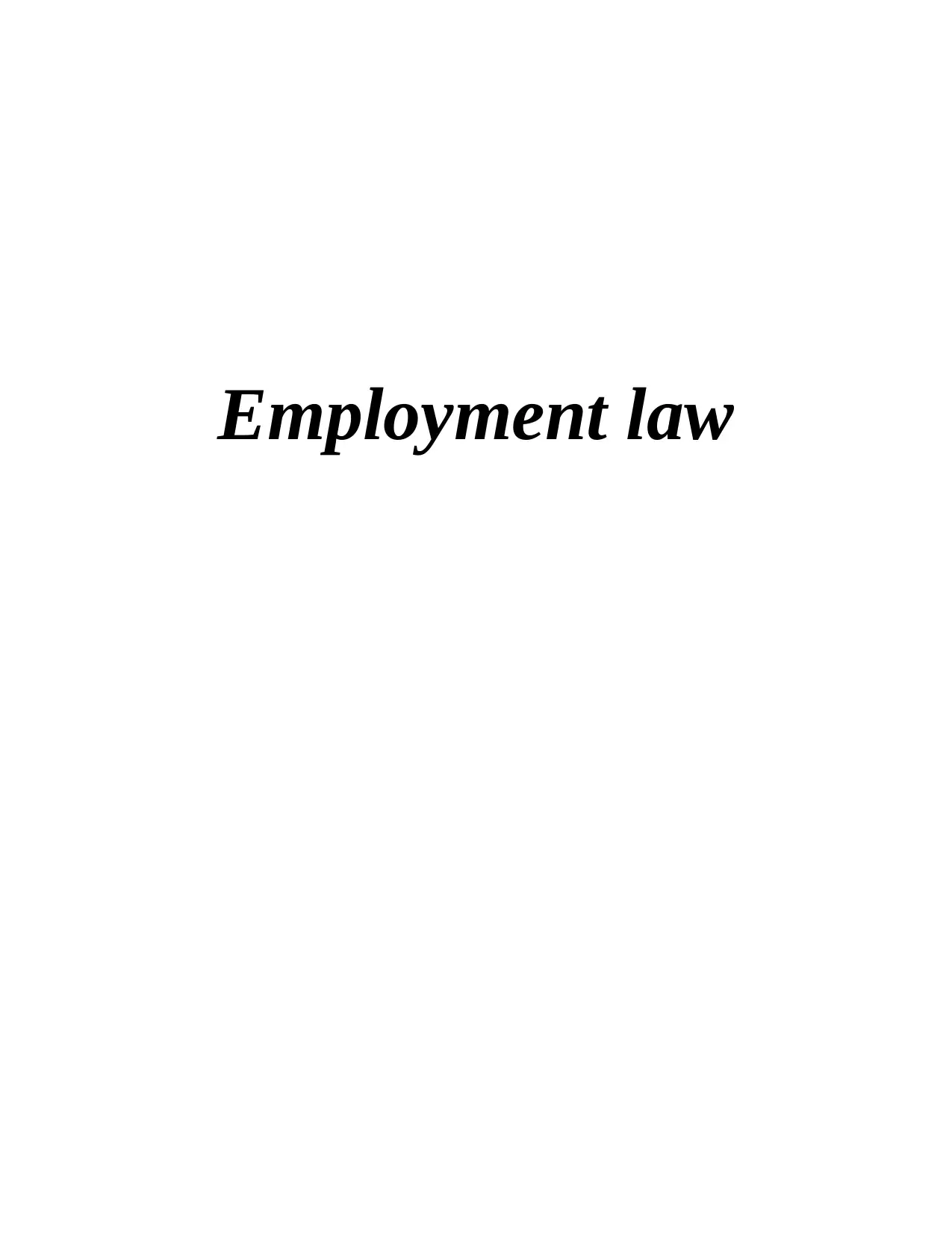
Employment law
Paraphrase This Document
Need a fresh take? Get an instant paraphrase of this document with our AI Paraphraser
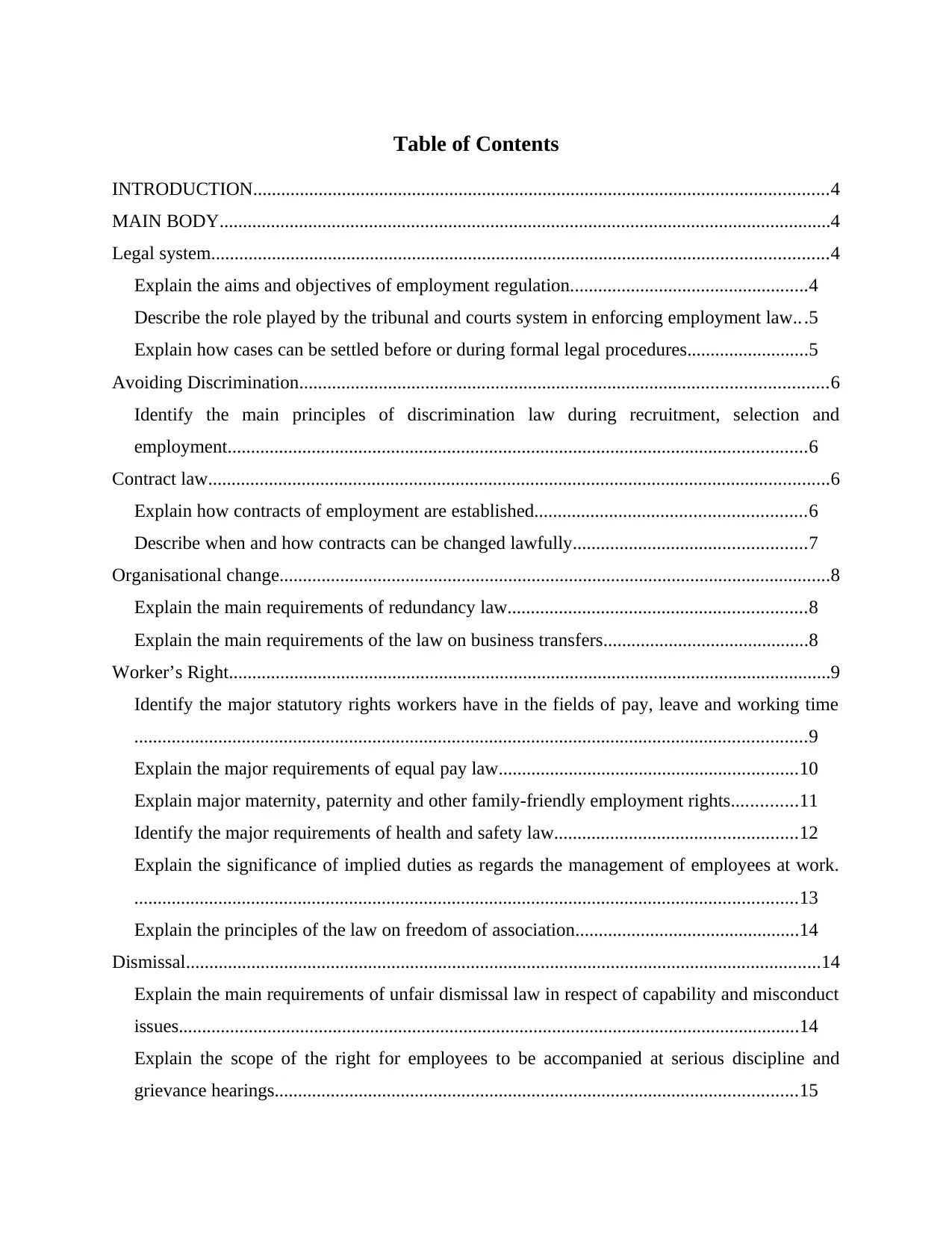
Table of Contents
INTRODUCTION...........................................................................................................................4
MAIN BODY...................................................................................................................................4
Legal system....................................................................................................................................4
Explain the aims and objectives of employment regulation...................................................4
Describe the role played by the tribunal and courts system in enforcing employment law...5
Explain how cases can be settled before or during formal legal procedures..........................5
Avoiding Discrimination.................................................................................................................6
Identify the main principles of discrimination law during recruitment, selection and
employment............................................................................................................................6
Contract law.....................................................................................................................................6
Explain how contracts of employment are established..........................................................6
Describe when and how contracts can be changed lawfully..................................................7
Organisational change......................................................................................................................8
Explain the main requirements of redundancy law................................................................8
Explain the main requirements of the law on business transfers............................................8
Worker’s Right.................................................................................................................................9
Identify the major statutory rights workers have in the fields of pay, leave and working time
................................................................................................................................................9
Explain the major requirements of equal pay law................................................................10
Explain major maternity, paternity and other family-friendly employment rights..............11
Identify the major requirements of health and safety law....................................................12
Explain the significance of implied duties as regards the management of employees at work.
..............................................................................................................................................13
Explain the principles of the law on freedom of association................................................14
Dismissal........................................................................................................................................14
Explain the main requirements of unfair dismissal law in respect of capability and misconduct
issues.....................................................................................................................................14
Explain the scope of the right for employees to be accompanied at serious discipline and
grievance hearings................................................................................................................15
INTRODUCTION...........................................................................................................................4
MAIN BODY...................................................................................................................................4
Legal system....................................................................................................................................4
Explain the aims and objectives of employment regulation...................................................4
Describe the role played by the tribunal and courts system in enforcing employment law...5
Explain how cases can be settled before or during formal legal procedures..........................5
Avoiding Discrimination.................................................................................................................6
Identify the main principles of discrimination law during recruitment, selection and
employment............................................................................................................................6
Contract law.....................................................................................................................................6
Explain how contracts of employment are established..........................................................6
Describe when and how contracts can be changed lawfully..................................................7
Organisational change......................................................................................................................8
Explain the main requirements of redundancy law................................................................8
Explain the main requirements of the law on business transfers............................................8
Worker’s Right.................................................................................................................................9
Identify the major statutory rights workers have in the fields of pay, leave and working time
................................................................................................................................................9
Explain the major requirements of equal pay law................................................................10
Explain major maternity, paternity and other family-friendly employment rights..............11
Identify the major requirements of health and safety law....................................................12
Explain the significance of implied duties as regards the management of employees at work.
..............................................................................................................................................13
Explain the principles of the law on freedom of association................................................14
Dismissal........................................................................................................................................14
Explain the main requirements of unfair dismissal law in respect of capability and misconduct
issues.....................................................................................................................................14
Explain the scope of the right for employees to be accompanied at serious discipline and
grievance hearings................................................................................................................15

CONCLUSION..............................................................................................................................16
REFERENCES..............................................................................................................................17
REFERENCES..............................................................................................................................17
⊘ This is a preview!⊘
Do you want full access?
Subscribe today to unlock all pages.

Trusted by 1+ million students worldwide
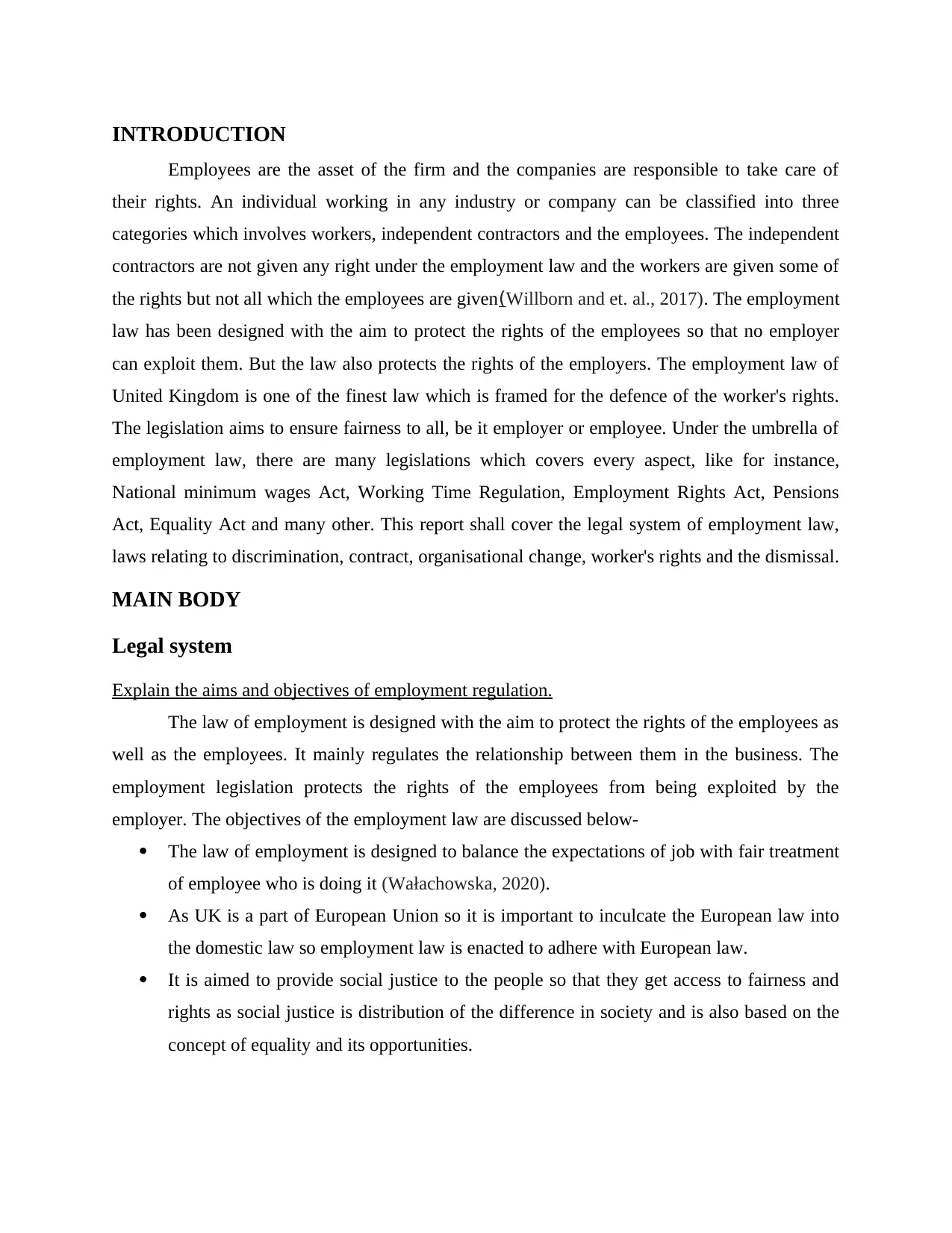
INTRODUCTION
Employees are the asset of the firm and the companies are responsible to take care of
their rights. An individual working in any industry or company can be classified into three
categories which involves workers, independent contractors and the employees. The independent
contractors are not given any right under the employment law and the workers are given some of
the rights but not all which the employees are given(Willborn and et. al., 2017). The employment
law has been designed with the aim to protect the rights of the employees so that no employer
can exploit them. But the law also protects the rights of the employers. The employment law of
United Kingdom is one of the finest law which is framed for the defence of the worker's rights.
The legislation aims to ensure fairness to all, be it employer or employee. Under the umbrella of
employment law, there are many legislations which covers every aspect, like for instance,
National minimum wages Act, Working Time Regulation, Employment Rights Act, Pensions
Act, Equality Act and many other. This report shall cover the legal system of employment law,
laws relating to discrimination, contract, organisational change, worker's rights and the dismissal.
MAIN BODY
Legal system
Explain the aims and objectives of employment regulation.
The law of employment is designed with the aim to protect the rights of the employees as
well as the employees. It mainly regulates the relationship between them in the business. The
employment legislation protects the rights of the employees from being exploited by the
employer. The objectives of the employment law are discussed below-
The law of employment is designed to balance the expectations of job with fair treatment
of employee who is doing it (Wałachowska, 2020).
As UK is a part of European Union so it is important to inculcate the European law into
the domestic law so employment law is enacted to adhere with European law.
It is aimed to provide social justice to the people so that they get access to fairness and
rights as social justice is distribution of the difference in society and is also based on the
concept of equality and its opportunities.
Employees are the asset of the firm and the companies are responsible to take care of
their rights. An individual working in any industry or company can be classified into three
categories which involves workers, independent contractors and the employees. The independent
contractors are not given any right under the employment law and the workers are given some of
the rights but not all which the employees are given(Willborn and et. al., 2017). The employment
law has been designed with the aim to protect the rights of the employees so that no employer
can exploit them. But the law also protects the rights of the employers. The employment law of
United Kingdom is one of the finest law which is framed for the defence of the worker's rights.
The legislation aims to ensure fairness to all, be it employer or employee. Under the umbrella of
employment law, there are many legislations which covers every aspect, like for instance,
National minimum wages Act, Working Time Regulation, Employment Rights Act, Pensions
Act, Equality Act and many other. This report shall cover the legal system of employment law,
laws relating to discrimination, contract, organisational change, worker's rights and the dismissal.
MAIN BODY
Legal system
Explain the aims and objectives of employment regulation.
The law of employment is designed with the aim to protect the rights of the employees as
well as the employees. It mainly regulates the relationship between them in the business. The
employment legislation protects the rights of the employees from being exploited by the
employer. The objectives of the employment law are discussed below-
The law of employment is designed to balance the expectations of job with fair treatment
of employee who is doing it (Wałachowska, 2020).
As UK is a part of European Union so it is important to inculcate the European law into
the domestic law so employment law is enacted to adhere with European law.
It is aimed to provide social justice to the people so that they get access to fairness and
rights as social justice is distribution of the difference in society and is also based on the
concept of equality and its opportunities.
Paraphrase This Document
Need a fresh take? Get an instant paraphrase of this document with our AI Paraphraser

Describe the role played by the tribunal and courts system in enforcing employment law.
Employment tribunals are the member of UK Tribunal system which are regulated by
Administrative Justice and the Tribunal council. It is a public body which have the authority to
listen, judge and give the decision on the claims and the disputes which arise between the
employee and employer. The main role of the employment tribunal is to resolve the dispute
which may arise between the employer and employee in the workplace. It mainly hears and
decide the dispute on subjects like unfair or wrongful dismissal, equal pay claims,
discrimination, breach of contract and many other. The court in the case of R (Union) v. Lord
Chancellor held that Employment tribunal are essential part of enforcing the protective
legislation of employment(Snyder, 2017). The Parliament have provided them with the duty to
create the easy accessible system of the adjudication for hearing the employment claim.
The courts hear the matter when it is not adequately resolved by the tribunal and with the
application of the law of employment, the courts and tribunals too enforce the employment
legislation.
Firstly, the matter goes to ACAS for conciliation and if the parties are not satisfied with
the decision or suggestion of ACAS, then the dispute goes to employment tribunal. And after
aggrieved by the decision of ET, the party can place an appeal in Employment Appeal tribunal.
After this, the case goes to County court, then High court and lastly at the Supreme court which
is the last resort to resolve the dispute of employment.
Employment tribunals are the member of UK Tribunal system which are regulated by
Administrative Justice and the Tribunal council. It is a public body which have the authority to
listen, judge and give the decision on the claims and the disputes which arise between the
employee and employer. The main role of the employment tribunal is to resolve the dispute
which may arise between the employer and employee in the workplace. It mainly hears and
decide the dispute on subjects like unfair or wrongful dismissal, equal pay claims,
discrimination, breach of contract and many other. The court in the case of R (Union) v. Lord
Chancellor held that Employment tribunal are essential part of enforcing the protective
legislation of employment(Snyder, 2017). The Parliament have provided them with the duty to
create the easy accessible system of the adjudication for hearing the employment claim.
The courts hear the matter when it is not adequately resolved by the tribunal and with the
application of the law of employment, the courts and tribunals too enforce the employment
legislation.
Firstly, the matter goes to ACAS for conciliation and if the parties are not satisfied with
the decision or suggestion of ACAS, then the dispute goes to employment tribunal. And after
aggrieved by the decision of ET, the party can place an appeal in Employment Appeal tribunal.
After this, the case goes to County court, then High court and lastly at the Supreme court which
is the last resort to resolve the dispute of employment.

Explain how cases can be settled before or during formal legal procedures.
If any dispute arises between the employer and the employer, the aggrieved party shall
refer the dispute to the Employment Tribunal.
The starting process is that the ACAS (Advisory, Conciliation and Arbitration Service)
should be notified within 3 months about the existence of claim and invoke the Early
Conciliation Service. The party can also seek other alternative resolutions apart from
conciliation which includes mediation or arbitration. Mediation is the process which
involves appointing the mediator who mediates between the parties and offer suggestions.
The parties are not bound to adhere with the suggestions. On other side, arbitration is a
process where an independent arbitrator is appointed who after examining the facts and
evidence, passes an award which is binding on the parties.
When ACAS is contacted, the claim is paused up to 6 weeks and if the claim is not
settled by that time, ACAS shall bring early conciliation service and issue the formal
Illustration 1: UK court structure
If any dispute arises between the employer and the employer, the aggrieved party shall
refer the dispute to the Employment Tribunal.
The starting process is that the ACAS (Advisory, Conciliation and Arbitration Service)
should be notified within 3 months about the existence of claim and invoke the Early
Conciliation Service. The party can also seek other alternative resolutions apart from
conciliation which includes mediation or arbitration. Mediation is the process which
involves appointing the mediator who mediates between the parties and offer suggestions.
The parties are not bound to adhere with the suggestions. On other side, arbitration is a
process where an independent arbitrator is appointed who after examining the facts and
evidence, passes an award which is binding on the parties.
When ACAS is contacted, the claim is paused up to 6 weeks and if the claim is not
settled by that time, ACAS shall bring early conciliation service and issue the formal
Illustration 1: UK court structure
⊘ This is a preview!⊘
Do you want full access?
Subscribe today to unlock all pages.

Trusted by 1+ million students worldwide
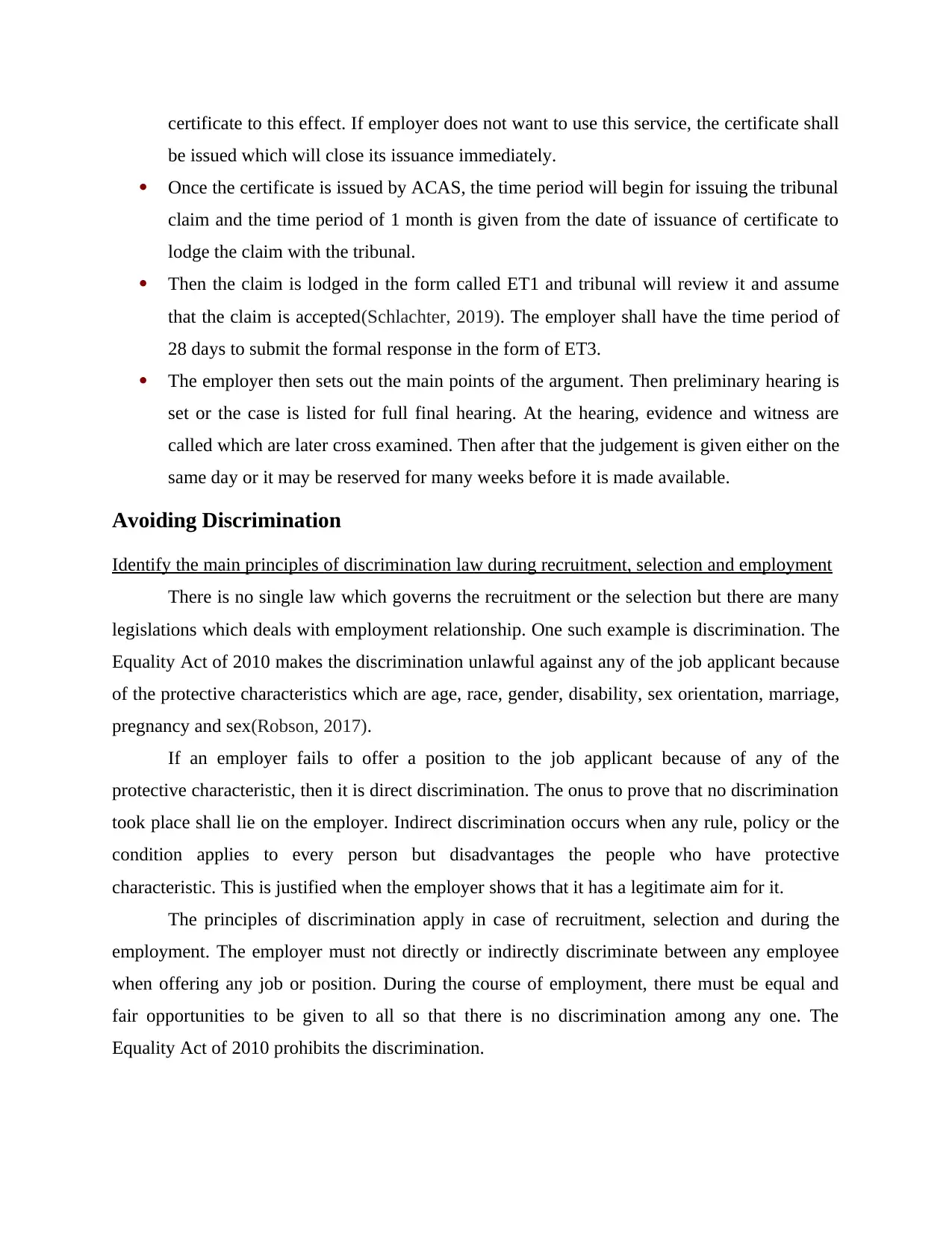
certificate to this effect. If employer does not want to use this service, the certificate shall
be issued which will close its issuance immediately.
Once the certificate is issued by ACAS, the time period will begin for issuing the tribunal
claim and the time period of 1 month is given from the date of issuance of certificate to
lodge the claim with the tribunal.
Then the claim is lodged in the form called ET1 and tribunal will review it and assume
that the claim is accepted(Schlachter, 2019). The employer shall have the time period of
28 days to submit the formal response in the form of ET3.
The employer then sets out the main points of the argument. Then preliminary hearing is
set or the case is listed for full final hearing. At the hearing, evidence and witness are
called which are later cross examined. Then after that the judgement is given either on the
same day or it may be reserved for many weeks before it is made available.
Avoiding Discrimination
Identify the main principles of discrimination law during recruitment, selection and employment
There is no single law which governs the recruitment or the selection but there are many
legislations which deals with employment relationship. One such example is discrimination. The
Equality Act of 2010 makes the discrimination unlawful against any of the job applicant because
of the protective characteristics which are age, race, gender, disability, sex orientation, marriage,
pregnancy and sex(Robson, 2017).
If an employer fails to offer a position to the job applicant because of any of the
protective characteristic, then it is direct discrimination. The onus to prove that no discrimination
took place shall lie on the employer. Indirect discrimination occurs when any rule, policy or the
condition applies to every person but disadvantages the people who have protective
characteristic. This is justified when the employer shows that it has a legitimate aim for it.
The principles of discrimination apply in case of recruitment, selection and during the
employment. The employer must not directly or indirectly discriminate between any employee
when offering any job or position. During the course of employment, there must be equal and
fair opportunities to be given to all so that there is no discrimination among any one. The
Equality Act of 2010 prohibits the discrimination.
be issued which will close its issuance immediately.
Once the certificate is issued by ACAS, the time period will begin for issuing the tribunal
claim and the time period of 1 month is given from the date of issuance of certificate to
lodge the claim with the tribunal.
Then the claim is lodged in the form called ET1 and tribunal will review it and assume
that the claim is accepted(Schlachter, 2019). The employer shall have the time period of
28 days to submit the formal response in the form of ET3.
The employer then sets out the main points of the argument. Then preliminary hearing is
set or the case is listed for full final hearing. At the hearing, evidence and witness are
called which are later cross examined. Then after that the judgement is given either on the
same day or it may be reserved for many weeks before it is made available.
Avoiding Discrimination
Identify the main principles of discrimination law during recruitment, selection and employment
There is no single law which governs the recruitment or the selection but there are many
legislations which deals with employment relationship. One such example is discrimination. The
Equality Act of 2010 makes the discrimination unlawful against any of the job applicant because
of the protective characteristics which are age, race, gender, disability, sex orientation, marriage,
pregnancy and sex(Robson, 2017).
If an employer fails to offer a position to the job applicant because of any of the
protective characteristic, then it is direct discrimination. The onus to prove that no discrimination
took place shall lie on the employer. Indirect discrimination occurs when any rule, policy or the
condition applies to every person but disadvantages the people who have protective
characteristic. This is justified when the employer shows that it has a legitimate aim for it.
The principles of discrimination apply in case of recruitment, selection and during the
employment. The employer must not directly or indirectly discriminate between any employee
when offering any job or position. During the course of employment, there must be equal and
fair opportunities to be given to all so that there is no discrimination among any one. The
Equality Act of 2010 prohibits the discrimination.
Paraphrase This Document
Need a fresh take? Get an instant paraphrase of this document with our AI Paraphraser

Contract law
Explain how contracts of employment are established.
The employment contract is one of the specific type of contract in which one person is
obliged to perform the work under the direction of the other. It is the agreement which sets out
the employee's rights, duties, responsibilities and the employment conditions. These are mainly
known as terms of contract(Reed, 2020). Every employer is bound to give the employee the
contract of employment to the employee and both must stick to the contract until it ends or the
terms of contracts are changed. The contract of employment must be given within 2 months
from the start of work. As soon as the job is accepted by the employee, the employer must offer
the contract of employment. It may be in writing or in oral.
The essential elements of employment contract includes the following- An offer by one party- It is a promise to do or not to do something by the party. Acceptance- The other party accepts the offer and acceptance must be clearly
communicated to the party either orally or in writing. Consideration- It is a value or sum which is necessary in the contract.
Intention to create legal relations- In case of commercial contract, a presumption is
raised that the parties have intention to create legal relations.
There are express and implied terms of the contract. Express terms are such which are
stated actually in writing(Pavlovskaya, 2017). For example, they pay, number of working hours,
holiday pay, sick pay and many other and the implied terms are not written anywhere rather they
are presumed. For instance, duty of mutual confidence and trust or duty to provide safe system of
the work or the workplace. The contract of employment states the rights of the employees which
includes reasonable notice, unfair dismissal, right to return to work and many other.
Describe when and how contracts can be changed lawfully
The contract of employment makes sure that the employee is aware of its duties and
responsibilities and the employer also works to protect the rights of the employee. There are
three ways in which the contract of employment can be changed which includes the following-
The employee must be given a notice about the change in contract of employee and it
must agree to it.
Explain how contracts of employment are established.
The employment contract is one of the specific type of contract in which one person is
obliged to perform the work under the direction of the other. It is the agreement which sets out
the employee's rights, duties, responsibilities and the employment conditions. These are mainly
known as terms of contract(Reed, 2020). Every employer is bound to give the employee the
contract of employment to the employee and both must stick to the contract until it ends or the
terms of contracts are changed. The contract of employment must be given within 2 months
from the start of work. As soon as the job is accepted by the employee, the employer must offer
the contract of employment. It may be in writing or in oral.
The essential elements of employment contract includes the following- An offer by one party- It is a promise to do or not to do something by the party. Acceptance- The other party accepts the offer and acceptance must be clearly
communicated to the party either orally or in writing. Consideration- It is a value or sum which is necessary in the contract.
Intention to create legal relations- In case of commercial contract, a presumption is
raised that the parties have intention to create legal relations.
There are express and implied terms of the contract. Express terms are such which are
stated actually in writing(Pavlovskaya, 2017). For example, they pay, number of working hours,
holiday pay, sick pay and many other and the implied terms are not written anywhere rather they
are presumed. For instance, duty of mutual confidence and trust or duty to provide safe system of
the work or the workplace. The contract of employment states the rights of the employees which
includes reasonable notice, unfair dismissal, right to return to work and many other.
Describe when and how contracts can be changed lawfully
The contract of employment makes sure that the employee is aware of its duties and
responsibilities and the employer also works to protect the rights of the employee. There are
three ways in which the contract of employment can be changed which includes the following-
The employee must be given a notice about the change in contract of employee and it
must agree to it.
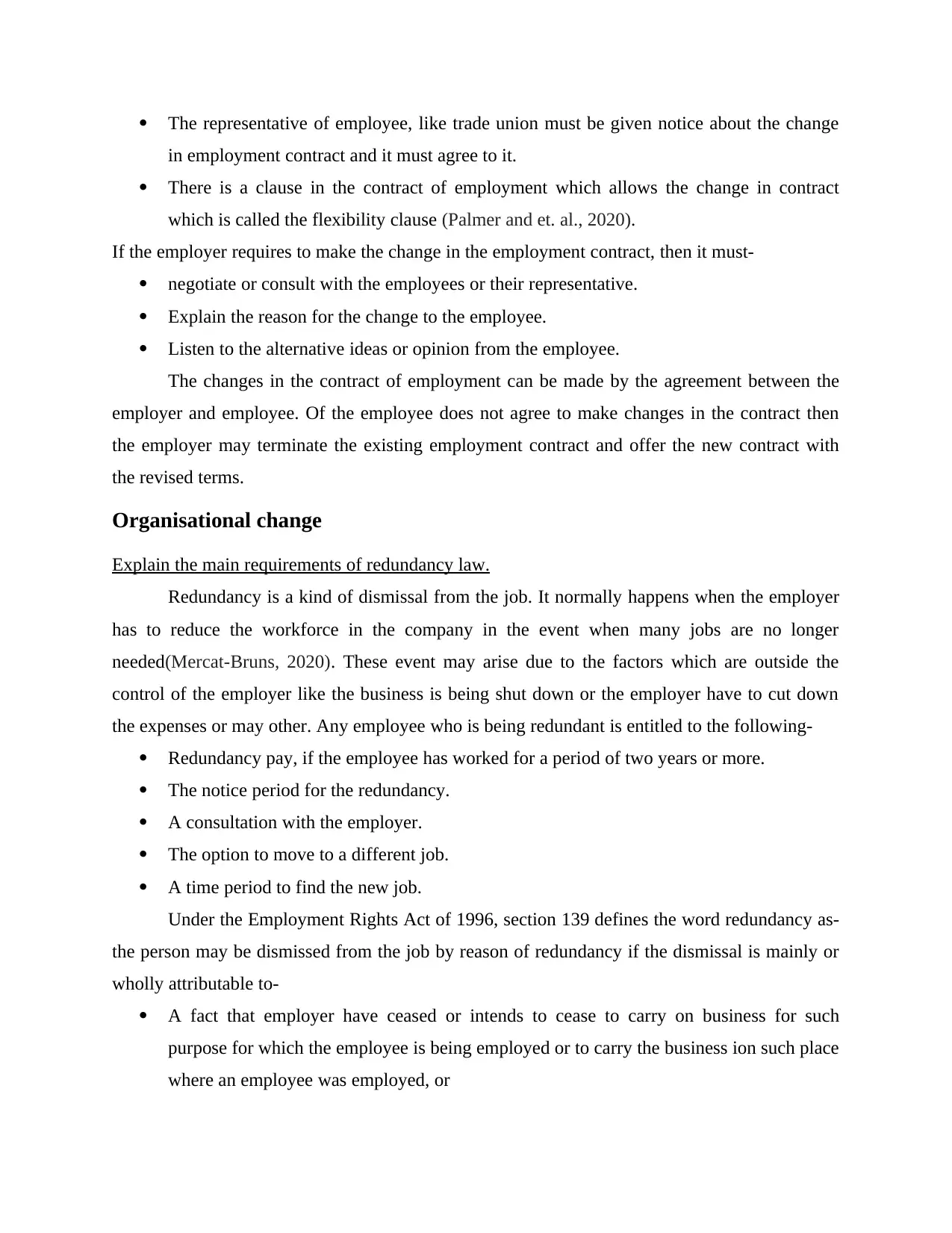
The representative of employee, like trade union must be given notice about the change
in employment contract and it must agree to it.
There is a clause in the contract of employment which allows the change in contract
which is called the flexibility clause (Palmer and et. al., 2020).
If the employer requires to make the change in the employment contract, then it must-
negotiate or consult with the employees or their representative.
Explain the reason for the change to the employee.
Listen to the alternative ideas or opinion from the employee.
The changes in the contract of employment can be made by the agreement between the
employer and employee. Of the employee does not agree to make changes in the contract then
the employer may terminate the existing employment contract and offer the new contract with
the revised terms.
Organisational change
Explain the main requirements of redundancy law.
Redundancy is a kind of dismissal from the job. It normally happens when the employer
has to reduce the workforce in the company in the event when many jobs are no longer
needed(Mercat-Bruns, 2020). These event may arise due to the factors which are outside the
control of the employer like the business is being shut down or the employer have to cut down
the expenses or may other. Any employee who is being redundant is entitled to the following-
Redundancy pay, if the employee has worked for a period of two years or more.
The notice period for the redundancy.
A consultation with the employer.
The option to move to a different job.
A time period to find the new job.
Under the Employment Rights Act of 1996, section 139 defines the word redundancy as-
the person may be dismissed from the job by reason of redundancy if the dismissal is mainly or
wholly attributable to-
A fact that employer have ceased or intends to cease to carry on business for such
purpose for which the employee is being employed or to carry the business ion such place
where an employee was employed, or
in employment contract and it must agree to it.
There is a clause in the contract of employment which allows the change in contract
which is called the flexibility clause (Palmer and et. al., 2020).
If the employer requires to make the change in the employment contract, then it must-
negotiate or consult with the employees or their representative.
Explain the reason for the change to the employee.
Listen to the alternative ideas or opinion from the employee.
The changes in the contract of employment can be made by the agreement between the
employer and employee. Of the employee does not agree to make changes in the contract then
the employer may terminate the existing employment contract and offer the new contract with
the revised terms.
Organisational change
Explain the main requirements of redundancy law.
Redundancy is a kind of dismissal from the job. It normally happens when the employer
has to reduce the workforce in the company in the event when many jobs are no longer
needed(Mercat-Bruns, 2020). These event may arise due to the factors which are outside the
control of the employer like the business is being shut down or the employer have to cut down
the expenses or may other. Any employee who is being redundant is entitled to the following-
Redundancy pay, if the employee has worked for a period of two years or more.
The notice period for the redundancy.
A consultation with the employer.
The option to move to a different job.
A time period to find the new job.
Under the Employment Rights Act of 1996, section 139 defines the word redundancy as-
the person may be dismissed from the job by reason of redundancy if the dismissal is mainly or
wholly attributable to-
A fact that employer have ceased or intends to cease to carry on business for such
purpose for which the employee is being employed or to carry the business ion such place
where an employee was employed, or
⊘ This is a preview!⊘
Do you want full access?
Subscribe today to unlock all pages.

Trusted by 1+ million students worldwide
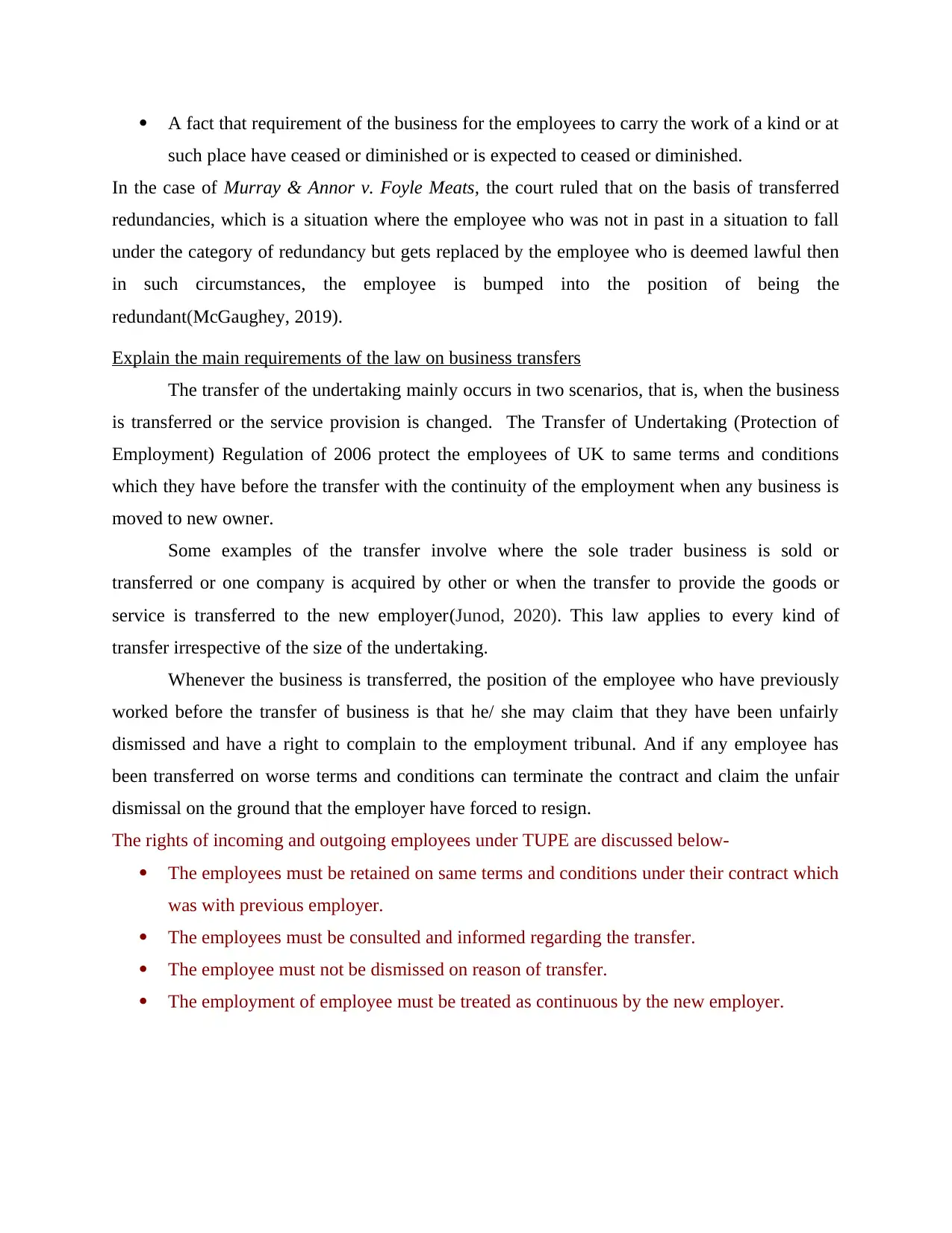
A fact that requirement of the business for the employees to carry the work of a kind or at
such place have ceased or diminished or is expected to ceased or diminished.
In the case of Murray & Annor v. Foyle Meats, the court ruled that on the basis of transferred
redundancies, which is a situation where the employee who was not in past in a situation to fall
under the category of redundancy but gets replaced by the employee who is deemed lawful then
in such circumstances, the employee is bumped into the position of being the
redundant(McGaughey, 2019).
Explain the main requirements of the law on business transfers
The transfer of the undertaking mainly occurs in two scenarios, that is, when the business
is transferred or the service provision is changed. The Transfer of Undertaking (Protection of
Employment) Regulation of 2006 protect the employees of UK to same terms and conditions
which they have before the transfer with the continuity of the employment when any business is
moved to new owner.
Some examples of the transfer involve where the sole trader business is sold or
transferred or one company is acquired by other or when the transfer to provide the goods or
service is transferred to the new employer(Junod, 2020). This law applies to every kind of
transfer irrespective of the size of the undertaking.
Whenever the business is transferred, the position of the employee who have previously
worked before the transfer of business is that he/ she may claim that they have been unfairly
dismissed and have a right to complain to the employment tribunal. And if any employee has
been transferred on worse terms and conditions can terminate the contract and claim the unfair
dismissal on the ground that the employer have forced to resign.
The rights of incoming and outgoing employees under TUPE are discussed below-
The employees must be retained on same terms and conditions under their contract which
was with previous employer.
The employees must be consulted and informed regarding the transfer.
The employee must not be dismissed on reason of transfer.
The employment of employee must be treated as continuous by the new employer.
such place have ceased or diminished or is expected to ceased or diminished.
In the case of Murray & Annor v. Foyle Meats, the court ruled that on the basis of transferred
redundancies, which is a situation where the employee who was not in past in a situation to fall
under the category of redundancy but gets replaced by the employee who is deemed lawful then
in such circumstances, the employee is bumped into the position of being the
redundant(McGaughey, 2019).
Explain the main requirements of the law on business transfers
The transfer of the undertaking mainly occurs in two scenarios, that is, when the business
is transferred or the service provision is changed. The Transfer of Undertaking (Protection of
Employment) Regulation of 2006 protect the employees of UK to same terms and conditions
which they have before the transfer with the continuity of the employment when any business is
moved to new owner.
Some examples of the transfer involve where the sole trader business is sold or
transferred or one company is acquired by other or when the transfer to provide the goods or
service is transferred to the new employer(Junod, 2020). This law applies to every kind of
transfer irrespective of the size of the undertaking.
Whenever the business is transferred, the position of the employee who have previously
worked before the transfer of business is that he/ she may claim that they have been unfairly
dismissed and have a right to complain to the employment tribunal. And if any employee has
been transferred on worse terms and conditions can terminate the contract and claim the unfair
dismissal on the ground that the employer have forced to resign.
The rights of incoming and outgoing employees under TUPE are discussed below-
The employees must be retained on same terms and conditions under their contract which
was with previous employer.
The employees must be consulted and informed regarding the transfer.
The employee must not be dismissed on reason of transfer.
The employment of employee must be treated as continuous by the new employer.
Paraphrase This Document
Need a fresh take? Get an instant paraphrase of this document with our AI Paraphraser
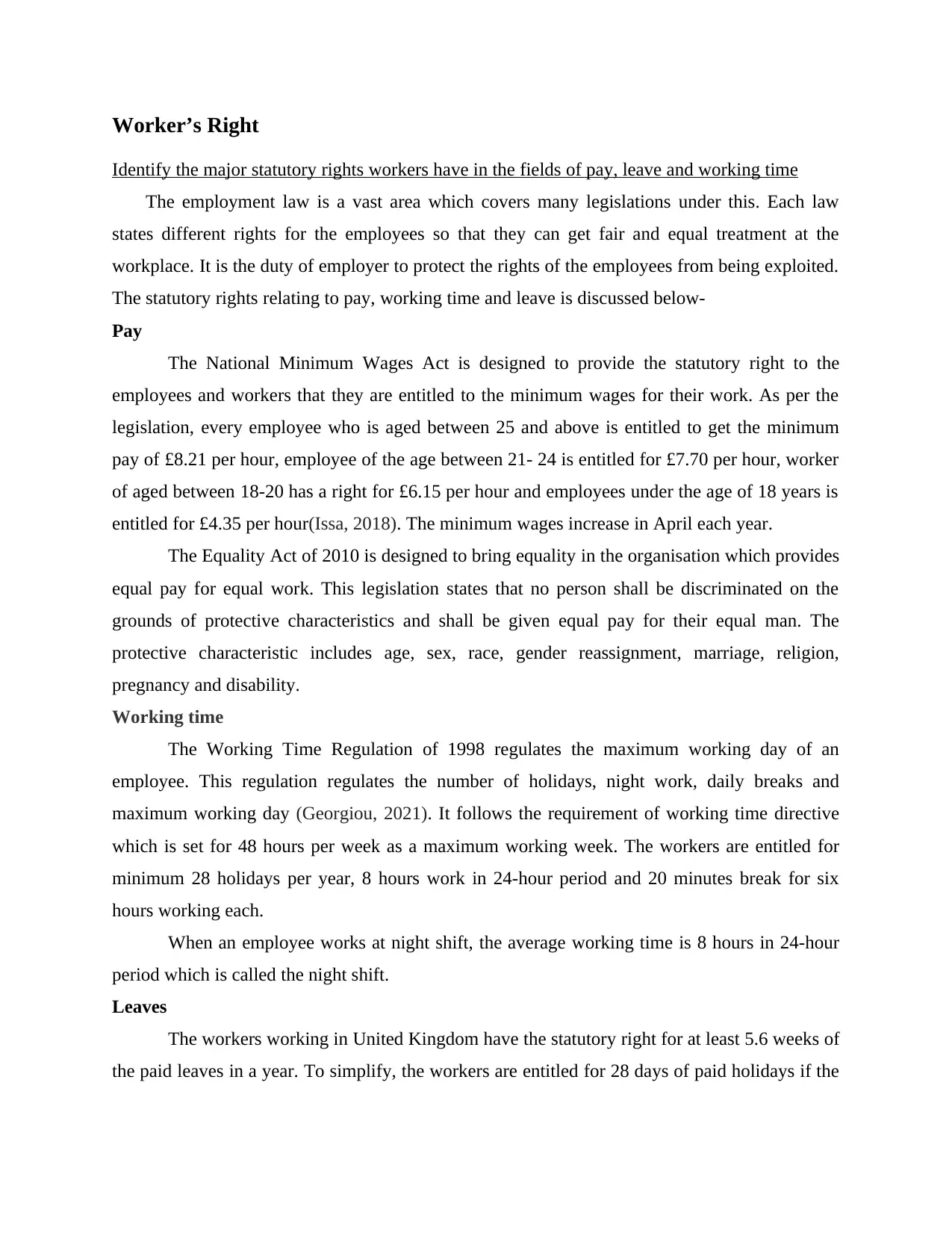
Worker’s Right
Identify the major statutory rights workers have in the fields of pay, leave and working time
The employment law is a vast area which covers many legislations under this. Each law
states different rights for the employees so that they can get fair and equal treatment at the
workplace. It is the duty of employer to protect the rights of the employees from being exploited.
The statutory rights relating to pay, working time and leave is discussed below-
Pay
The National Minimum Wages Act is designed to provide the statutory right to the
employees and workers that they are entitled to the minimum wages for their work. As per the
legislation, every employee who is aged between 25 and above is entitled to get the minimum
pay of £8.21 per hour, employee of the age between 21- 24 is entitled for £7.70 per hour, worker
of aged between 18-20 has a right for £6.15 per hour and employees under the age of 18 years is
entitled for £4.35 per hour(Issa, 2018). The minimum wages increase in April each year.
The Equality Act of 2010 is designed to bring equality in the organisation which provides
equal pay for equal work. This legislation states that no person shall be discriminated on the
grounds of protective characteristics and shall be given equal pay for their equal man. The
protective characteristic includes age, sex, race, gender reassignment, marriage, religion,
pregnancy and disability.
Working time
The Working Time Regulation of 1998 regulates the maximum working day of an
employee. This regulation regulates the number of holidays, night work, daily breaks and
maximum working day (Georgiou, 2021). It follows the requirement of working time directive
which is set for 48 hours per week as a maximum working week. The workers are entitled for
minimum 28 holidays per year, 8 hours work in 24-hour period and 20 minutes break for six
hours working each.
When an employee works at night shift, the average working time is 8 hours in 24-hour
period which is called the night shift.
Leaves
The workers working in United Kingdom have the statutory right for at least 5.6 weeks of
the paid leaves in a year. To simplify, the workers are entitled for 28 days of paid holidays if the
Identify the major statutory rights workers have in the fields of pay, leave and working time
The employment law is a vast area which covers many legislations under this. Each law
states different rights for the employees so that they can get fair and equal treatment at the
workplace. It is the duty of employer to protect the rights of the employees from being exploited.
The statutory rights relating to pay, working time and leave is discussed below-
Pay
The National Minimum Wages Act is designed to provide the statutory right to the
employees and workers that they are entitled to the minimum wages for their work. As per the
legislation, every employee who is aged between 25 and above is entitled to get the minimum
pay of £8.21 per hour, employee of the age between 21- 24 is entitled for £7.70 per hour, worker
of aged between 18-20 has a right for £6.15 per hour and employees under the age of 18 years is
entitled for £4.35 per hour(Issa, 2018). The minimum wages increase in April each year.
The Equality Act of 2010 is designed to bring equality in the organisation which provides
equal pay for equal work. This legislation states that no person shall be discriminated on the
grounds of protective characteristics and shall be given equal pay for their equal man. The
protective characteristic includes age, sex, race, gender reassignment, marriage, religion,
pregnancy and disability.
Working time
The Working Time Regulation of 1998 regulates the maximum working day of an
employee. This regulation regulates the number of holidays, night work, daily breaks and
maximum working day (Georgiou, 2021). It follows the requirement of working time directive
which is set for 48 hours per week as a maximum working week. The workers are entitled for
minimum 28 holidays per year, 8 hours work in 24-hour period and 20 minutes break for six
hours working each.
When an employee works at night shift, the average working time is 8 hours in 24-hour
period which is called the night shift.
Leaves
The workers working in United Kingdom have the statutory right for at least 5.6 weeks of
the paid leaves in a year. To simplify, the workers are entitled for 28 days of paid holidays if the
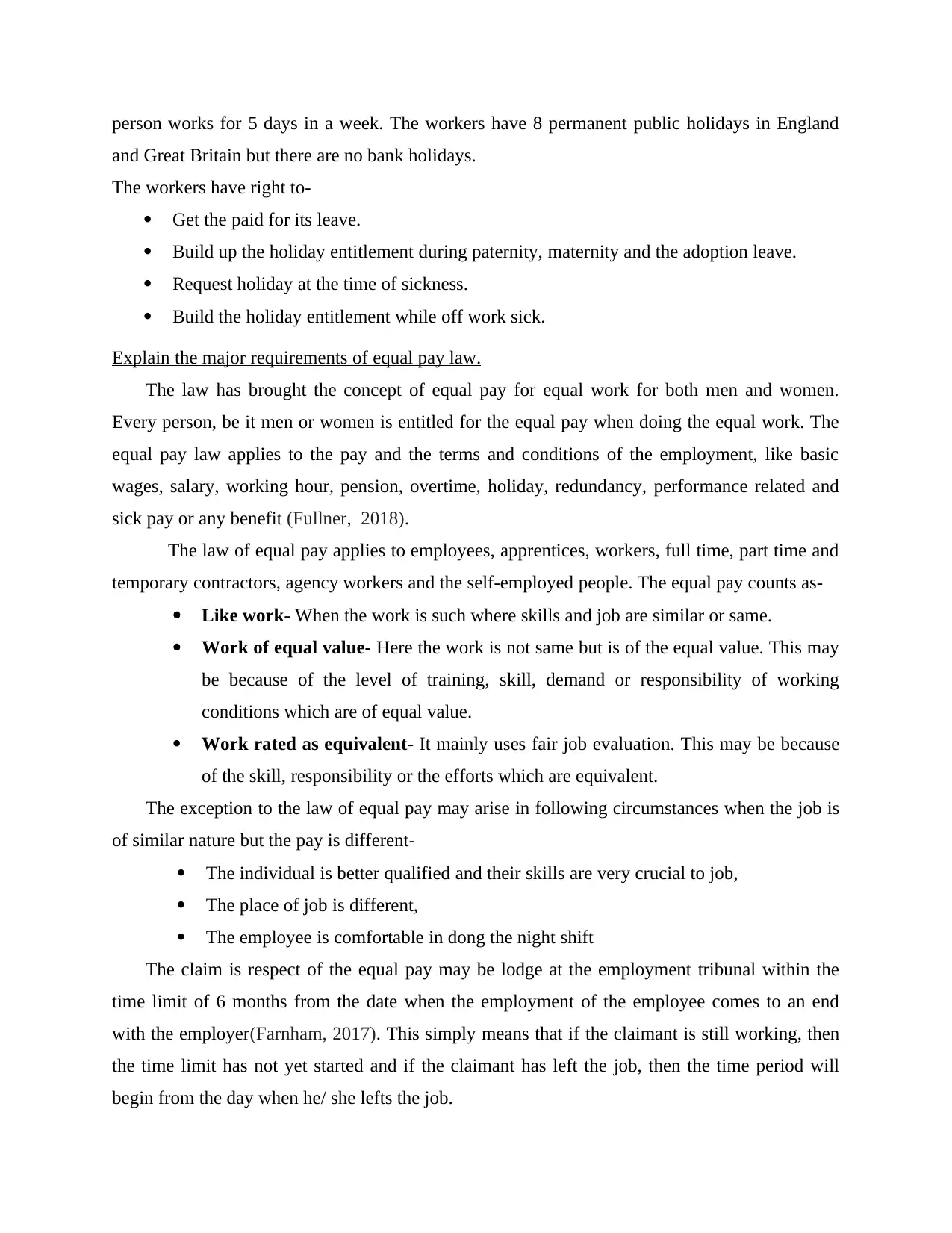
person works for 5 days in a week. The workers have 8 permanent public holidays in England
and Great Britain but there are no bank holidays.
The workers have right to-
Get the paid for its leave.
Build up the holiday entitlement during paternity, maternity and the adoption leave.
Request holiday at the time of sickness.
Build the holiday entitlement while off work sick.
Explain the major requirements of equal pay law.
The law has brought the concept of equal pay for equal work for both men and women.
Every person, be it men or women is entitled for the equal pay when doing the equal work. The
equal pay law applies to the pay and the terms and conditions of the employment, like basic
wages, salary, working hour, pension, overtime, holiday, redundancy, performance related and
sick pay or any benefit (Fullner, 2018).
The law of equal pay applies to employees, apprentices, workers, full time, part time and
temporary contractors, agency workers and the self-employed people. The equal pay counts as-
Like work- When the work is such where skills and job are similar or same.
Work of equal value- Here the work is not same but is of the equal value. This may
be because of the level of training, skill, demand or responsibility of working
conditions which are of equal value.
Work rated as equivalent- It mainly uses fair job evaluation. This may be because
of the skill, responsibility or the efforts which are equivalent.
The exception to the law of equal pay may arise in following circumstances when the job is
of similar nature but the pay is different-
The individual is better qualified and their skills are very crucial to job,
The place of job is different,
The employee is comfortable in dong the night shift
The claim is respect of the equal pay may be lodge at the employment tribunal within the
time limit of 6 months from the date when the employment of the employee comes to an end
with the employer(Farnham, 2017). This simply means that if the claimant is still working, then
the time limit has not yet started and if the claimant has left the job, then the time period will
begin from the day when he/ she lefts the job.
and Great Britain but there are no bank holidays.
The workers have right to-
Get the paid for its leave.
Build up the holiday entitlement during paternity, maternity and the adoption leave.
Request holiday at the time of sickness.
Build the holiday entitlement while off work sick.
Explain the major requirements of equal pay law.
The law has brought the concept of equal pay for equal work for both men and women.
Every person, be it men or women is entitled for the equal pay when doing the equal work. The
equal pay law applies to the pay and the terms and conditions of the employment, like basic
wages, salary, working hour, pension, overtime, holiday, redundancy, performance related and
sick pay or any benefit (Fullner, 2018).
The law of equal pay applies to employees, apprentices, workers, full time, part time and
temporary contractors, agency workers and the self-employed people. The equal pay counts as-
Like work- When the work is such where skills and job are similar or same.
Work of equal value- Here the work is not same but is of the equal value. This may
be because of the level of training, skill, demand or responsibility of working
conditions which are of equal value.
Work rated as equivalent- It mainly uses fair job evaluation. This may be because
of the skill, responsibility or the efforts which are equivalent.
The exception to the law of equal pay may arise in following circumstances when the job is
of similar nature but the pay is different-
The individual is better qualified and their skills are very crucial to job,
The place of job is different,
The employee is comfortable in dong the night shift
The claim is respect of the equal pay may be lodge at the employment tribunal within the
time limit of 6 months from the date when the employment of the employee comes to an end
with the employer(Farnham, 2017). This simply means that if the claimant is still working, then
the time limit has not yet started and if the claimant has left the job, then the time period will
begin from the day when he/ she lefts the job.
⊘ This is a preview!⊘
Do you want full access?
Subscribe today to unlock all pages.

Trusted by 1+ million students worldwide
1 out of 20
Related Documents
Your All-in-One AI-Powered Toolkit for Academic Success.
+13062052269
info@desklib.com
Available 24*7 on WhatsApp / Email
![[object Object]](/_next/static/media/star-bottom.7253800d.svg)
Unlock your academic potential
Copyright © 2020–2026 A2Z Services. All Rights Reserved. Developed and managed by ZUCOL.




